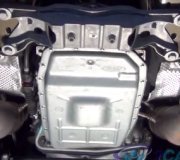The battery doesn't cause low system voltage when the engine is running. That's a problem with the charging system. The most common thing at the mileage you listed is worn brushes inside the alternator. The brush assembly is less than $25.00, and in many applications it can be replaced without removing the alternator from the engine. Most people just replace the entire alternator, but it should be diagnosed first because the most expensive way to fix a vehicle is to throw parts at it until it's fixed.
By disconnecting the battery, you introduced a bunch of new problems. There are over a dozen computer modules in the car that have lost their memory. Body controllers usually maintain their programming for speed-sensitive door locks, horn chirp, and things like that, but the engine and transmission computers have to go through a relearn procedure. Computers are extremely sensitive to supply voltage. It's anyone's guess how they will react or what bizarre things they will do until you get the charging system fixed.
The transmission computer runs four solenoids to select the different gears. The solenoids won't work properly with low system voltage. At the very least, the solenoids are spring-loaded to provide Park, reverse, neutral, and second gear. Rotten fuel mileage and performance, but you can drive it to the repair shop.
Once the charging system is repaired, the transmission will not shift smoothly until the computer relearns the characteristics of the clutch packs and other wear items. Typically this takes less than twelve shift cycles and about two miles including some highway travel.
The engine computer may not cause a noticeable problem during its relearn procedure, but it will start out delivering fuel according to factory-programmed values. The exhaust gases are constantly monitored and fuel metering is updated, then the new values are put in memory. This is an on-going process that occurs every time you drive the car.
To start the diagnostic procedure, use a digital voltmeter to measure battery voltage before you start the engine. A fully charged battery will measure about 12.6 volts. At less than 12.0 volts, consider slow-charging the battery for an hour. Fast-charging at a high rate usually won't hurt a new battery, but it can lead to rapid failure of an older battery. High charge rates should be avoided.
With the engine running, the battery voltage must be between 13.75 and 14.75 volts. If it is low, there are simple test that can be done with a voltmeter to test the alternator.
All these other problems started right after you replaced the battery, so common sense says the transmission didn't develop a problem at the same time.
Caradiodoc
SPONSORED LINKS
Wednesday, June 24th, 2009 AT 1:20 AM




